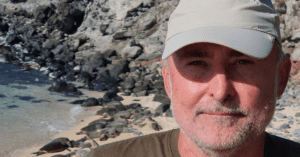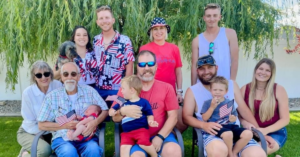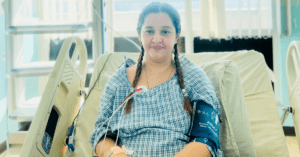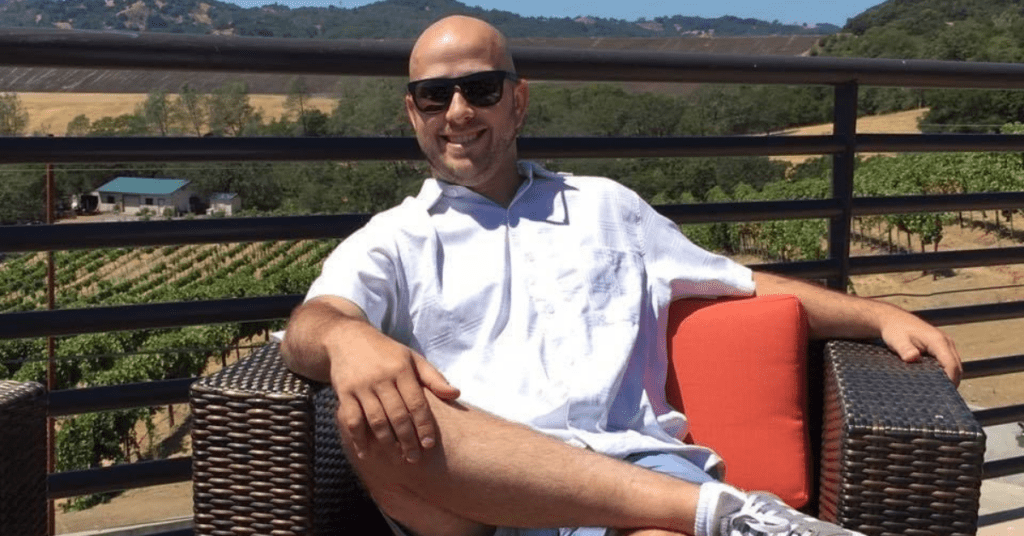I grew up in a small & rural town of about 3,500 people in central Minnesota. I was raised in a blue-collar middle class home, with both loving parents and two older brothers. I was an average athlete in high school (for a small town) playing football and baseball, and was involved in choir, plays and had various jobs since I was 15 years-old.
When I was growing up nothing was wrong with me, besides some people noticing I had a wide-based gait (direction of foot when walking). It wasn’t extreme, so no one was concerned. My father wasn’t showing any symptoms in his late 30’s, so nothing was alarming. It wasn’t until in my mid-20’s I started to notice small things while playing sports. I was a part of numerous sports clubs and actively played things like baseball, softball, basketball, and volleyball just to name a few. Sometimes my depth perception would be a little off or a leg would give out when I was running. I chalked it up to getting older, but I knew something was wrong. Around 26, I started going to the doctor to complain about these issues. I had X-rays, MRI, and blood tests but everything came up negative so I didn’t push the issue. My first inclination that something was definitely wrong was that I did an inflatable obstacle course horribly in the Summer of 2012 when I was living in Washington D.C.
I moved back to Minnesota when I was 29 in 2013, and had four instances that really prompted me to find more answers. I was playing softball one night and couldn’t do anything really efficiently (like fielding or hitting). I was a decent athlete before, so something felt definitely wrong. The second was falling off a ladder when I was working on gutters. There wasn’t any wind, but my balance was just off. Even climbing up the ladder was difficult. The third was that there were carpeted stairs in the house, and I started to notice I would fall more often if I didn’t hold the railing. The final was I was at a party with friends and my leg gave out, and I fell to the ground. I spent the next 6 months seeing a general physician, neurologists and doing numerous tests that all came up negative. Right before moving to California the doctors gave me a referral to go to the Mayo Clinic to see if they could figure it out. If you aren’t familiar, this is a world renowned hospital where many famous politicians come to get treatment. Within 5 minutes they gave me a visual diagnosis of ataxia, and wanted to see if my father could come in. I went again a couple days before the move and they confirmed it. However, they said there is no cure or effective treatment so not much we could do. I moved to California in a haze because I didn’t know what Ataxia was, or how it would affect me in the future.
I moved to northern California because of the amazing weather, and I got a job as an Assistant Principal at one of the best public middle schools in the nation. California is known for its hiking and surfing. However, after attempting both, they were extremely difficult. For my first two years in California I didn’t let my employer know, didn’t let my friends know, and still tried to do everything like I used to.
I moved to California in July of 2016 at 31 years old. Since I moved, I didn’t have a doctor, neurologist and just got separated so no one to really talk to. After settling into my place (moved from a 4 bedroom house to a 1 bedroom apartment) I decided to place my focus on my new job and making new friends, and put my diagnosis on the “back-burner”. I was noticing small things like walking to my seat with a small aisle (like at a sports event or movie theater) or having to put my shoes on while sitting down. My second year, I tried to coach a baseball team in the fall, but noticed I couldn’t hit the ball to the players or even play catch like I used to.
I found an Ataxia Support Group that I went to a few times, and saw people with much worse symptoms than me, but they were older. Since I know the disease was slowly progressive I felt I should start looking into it. In the summer of 2018, I decided to do genetic blood testing to figure out which type I had. I started the process, but after the insurance denial and the appeal process; I had to pay out-of-pocket (around $3,000) for the tests. I met with a genetics doctor in San Francisco, and my test came back inconclusive. The baseline gene panel tests for around 8 main genes, and I would want the secondary panel to tell all of the genes it would be about $2,000 more. I decided to do the secondary one too, but that came back inconclusive too. This time, they found a mutation of a gene, but there weren’t enough samples to definitively know what I had. That doctor advised me to wait a few years, but to start physical therapy.
I am stubborn, so I did some research and found a doctor (Dr. Brent Fogel) that was a specialist, and was looking for patients with my results. We met in November of 2019, and he confirmed that I have Spinocerebellar Ataxia, Version 28 (AKA SCA 28). Since it is a hereditary disease, he asked if anyone else in my family has it. Since very few doctors know about the disease and the symptoms, my immediate family was never tested. UCLA sent a saliva test, and one of my brothers went to Johns Hopkins for testing. Then, COVID-19 happened and all progress fell on the “back-burner” again.
I just put a note in my HR file, about my medical diagnosis and what restrictions should be made at work. In March 2020 with about a 1 hour notice, we were informed when we wouldn’t be returning until after Spring Break (which was only 3 weeks away). I spent the next 18 months doing Zoom, monitoring “asynchronous” instruction, and making the school safe for students to return.
Once the pandemic died down I decided to start researching again as my symptoms were getting worse. Rather than deal with staff and parent meetings, supervising school activities, and walking all over the campus everyday I decided to go back into teaching.
I was half-time at a middle school teaching 6th grade World History and half-time at a new high school Special Education program teaching social studies for students with anxiety, depression, and some behavioral issues. I split my time between both schools, but knew I wasn’t giving my all to the high school program because of time constraints. The next school year I was given the option for full-time at either location, and I chose the high school.
At the full-time high school location I had much smaller class sizes, but more work doing multiple subjects. I started to notice my speech slurring, my voice was strained at the end-of-the-day, and I was getting much more fatigued. To top it off, my classroom was set on fire at the end of the year. With everything, I felt I had one more year left in me.
Because of my horrible handwriting, slurred speech, and coordination issues; I used a lot more videos my last year. I had fill-in-the-blank notes, and let students do retakes on daily tasks and tests since I might have misspoke at some point. I applied for a sabbatical so I could research ways to still teach with the disease, but it was turned down. I had colleagues go on medical leave, friends from high school unexpectedly pass away, and realized I didn’t know much about the future of my health. I decided to take this year off of work. I plan to research the disease, be an advocate for others, travel the U.S (while I can), and figure out what I can do with my “new normal”. This is the first time in almost 25 years that I have had time off. I’m working through everything from disability benefits, to advocacy letters, to research about ataxia. I started a website called www.ataxiantraveler.com where I’ll post daily to the website, and will add a search bar soon for when I start posting about disability issues. Also, I created an Instagram, YouTube, and Facebook page.
When Were You Diagnosed? Which Type (If Known)?
Visually diagnosed at the Mayo Clinic in Minnesota, Officially diagnosed at UCLA. SCA28.
How Has Ataxia Impacted Your Life?
I had to quit my full time job (I have been a public school teacher since 2007 because of slurred speech and fall risk).
What is One Thing You’d Like the People to Know About Ataxia?
That I’m not drunk, that I just have Ataxia.
Share Your Advice – How Can Others Support Someone with Ataxia?
Be patient.
How has NAF Helped You or Your Family?
Started to get the resources in one place.
What is Your Ataxia Story?
As an organization dedicated to improving the lives of those affected by Ataxia, we believe that each story has the power to inspire, connect, and empower others. We invite you to share your personal Ataxia journey with us.
Are you here to read the personal stories, but haven’t yet joined as a member? We hope you find comfort in reading about the experiences of others on their Ataxia journey. We invite you to join as a member to receive a new member story each month. It’s free, and you’ll be kept up-to-date on the latest developments in the Ataxia community.
Recent Member Stories

Dušan Stojanovich
“His Light Endures”: Honoring Dušan Through Art and Advocacy By Dr. Nanette Presswell My partner Dušan was an extraordinary person—deeply creative, endlessly curious, and full Read More…

Marius
My Ataxia Journey: Sailing Uncharted Waters My name is Marius, and I live in Romania. I’m 64 years old, and I’ve always been an active, Read More…

Kamal Randhawa
I have a history of Ataxia. On my father’s side, all aunts and uncles are affected, their offspring too. We all have Ataxia. I was Read More…

Bev Schmutz
Hi! I was diagnosed in 2010. I worked for a well known insurance carrier. I had breast cancer in 2008 and received Chemo therapy, radiation Read More…

Purnima
Hello everyone, I used to live away from my home in Pokhara with my 3-year-old son for my job. I was a very confident girl Read More…

Sandra B
I’m Sandra. I’m 50 years old and based in Hamburg, Germany. There are some things I found out and experienced, and for I found them Read More…




